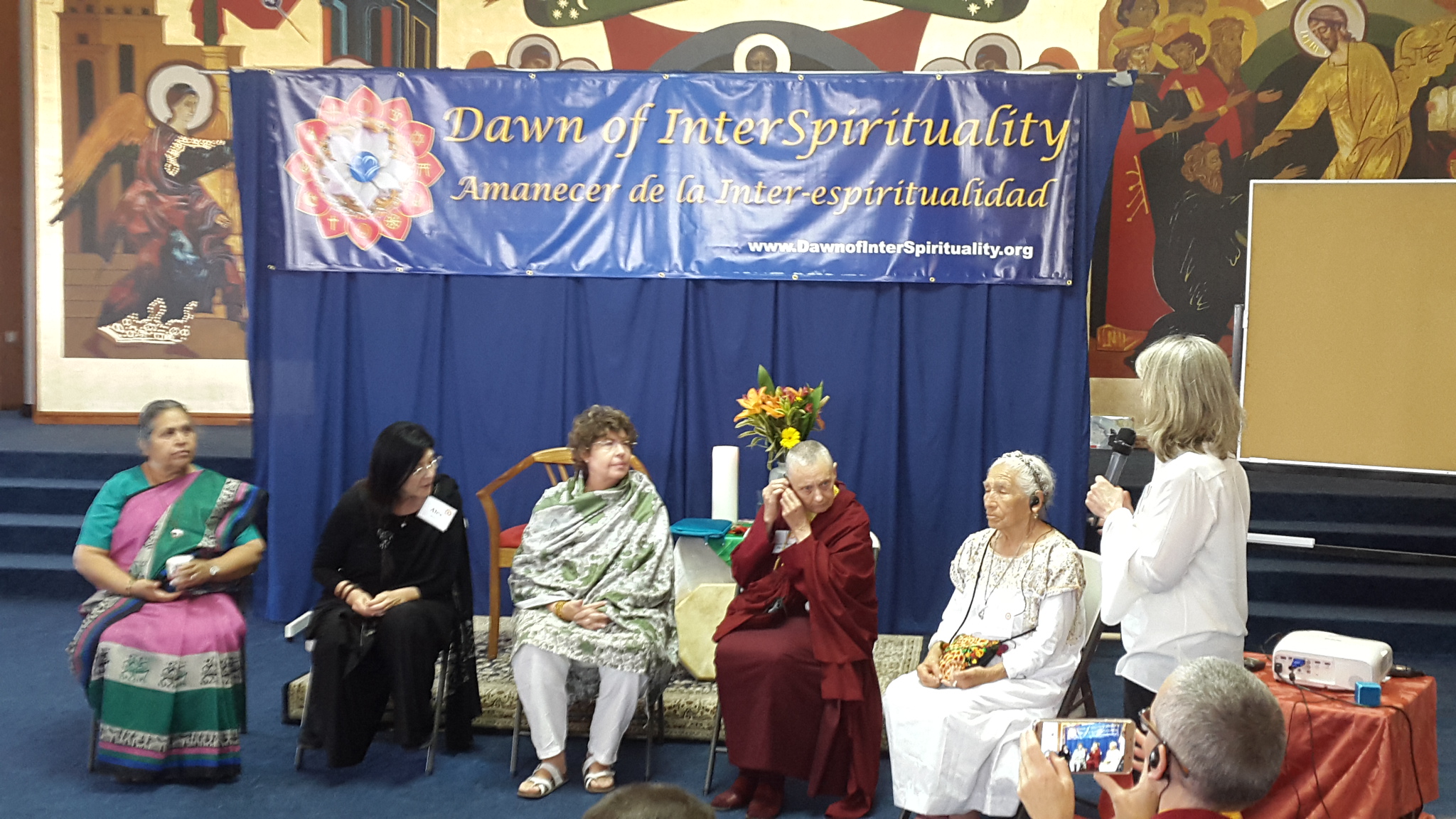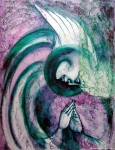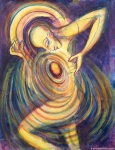From March 12 to 16, 2018, the Dawn of Interspirituality Conference was held at Casa Siloé in Birri de Heredia, Costa Rica. [1]
This bi-lingual Conference brought together ‘spiritual’ leaders and seekers from around the world to “build bridges of harmony, collaboration, and peace across the traditions.”
Some key presenters included Jetsunma Tenzin Palmo, Bishop Marc Andrus, Sister Lucy Kurien, Rev. Mads Christoffersen, and ‘Interfaith Amigos” Imam Jamal Rahman and Rabbi Ted Falcon. Click here to view the 2018 Conference Booklet with a full list of presenters at the 2018 Conference.
After I saw the event announced on Facebook, I thought about the possibility of attending, because it would be about interreligious dialogue and world peace.
The Conference was supported by Pope Francis. I knew that was the case because there is a picture of the Pope in the Vatican with Lucy Kurien, a Catholic nun who would attend the Conference.[2]
Both met on October 30, 2017, and when the Pope learned about the event he was excited.[3] Moreover, he blessed Lucy Kurien and the conference to be held in Costa Rica.[4]
Among the speakers would be the Muslim leader and Argentine deputy Omar Abboud; Rabbi Daniel Goldman and the Catholic priest Guillermo Marcó.[5]
Before continuing with the story, it should be noted that the three named have in common that they were co-founders of the Interreligious Dialogue Institute in Argentina and that they are old friends and current close collaborators of Pope Francis.[6] This Institute, which has the support of Pope Francis, is born from the spirit of the encyclical Laudato Si "and from the concern of religious traditions in the care of the environment."[7]
The Conference Statement reads:
“Featured presenters are dedicated to building bridges of harmony and collaboration across the world religions, including: Buddhist master Jetsunma Tenzin Palmo from India, Secretary General Mads Christoffersen of the National Council of Churches in Denmark, Catholic nun and human rights activist Sr. Lucy Kurien from India, Hindu master Swami Atmarupananda from the USA, Muslim interfaith leader Radwa Salah from Lebanon, the Bishop of California Marc Andrus from Grace Cathedral in San Francisco, Shaykah Amina al-Yerráhi of Mexico, indigenous Shaman Alberto Taxo from Ecuador, and Mayan healer Abuela Margarita from Mexico.”[8]
I did not attend every day of the Conference, but I attended on Thursday. Prior to arriving, I read about two activities on the schedule, and only those two, which were repeated in all five days of the conference:
Silent Contemplative Meditation / Prayer and music session.[9] Regarding Silent Contemplative Meditation / Prayer, it was performed twice on Monday 12; from Monday 13 to Tuesday 15 four times; and on Friday 16 only once.[10]
But the music sessions were held once a day.[11] With the exception of Monday, when it was in the afternoon, the rest of the days — it was part of the opening of the program, something very significant as we will see.
I thought it would be interesting to know what the Pope was supporting—if I saw it for myself. It was.
I attended on the 15th and arrived shortly before 12. Catholic priest Joson Tharakan John, parish priest of the diocese of Dehli in India, gave a talk in the Blue Room (rescheduled, since it was originally in the Red Room). Attendees were in other rooms where several of the other speakers gave their talks.
The priest Joson spoke of the way in which Roman Catholicism creates bridges of understanding through solidarity to achieve world peace. Among those listening were Buddhist representatives and the Catholic priest Guillermo Marcó, one of the friends and close collaborators of Pope Francis.
Joson Tharakan received much applause at the end of his talk.
Lunchtime
Finally, all the attendees (we were about one hundred people among all the rooms) had to go to the dining room for lunch. I greeted the priest Joson and asked him if we could talk. He nodded so I asked him about the Conference. He told me in a general way how the other days of the Conference had been. So I asked him:
Me (Gabriel): “I noticed that meditation and silent contemplative prayer sessions are scheduled every day. Is there any special reason why that is so?”
Priest Joson: “It is the most significant way that has helped us to unite us all in one purpose; here and everywhere ”
Me: “That is, is it the most important way to get all faiths together in one purpose and mission?”
Priest Joson: “Yes, that's right” -
Upon hearing something so significant, I could confirm that these methods of meditation and prayer are extremely important vehicles in the ecumenical movement. A young and very kind person who invited me to lunch in the dining room invited me to the table where he would sit. I saw in that table the priest Joson with three Buddhists and others. Among them, there was a liaison person to the United Nations whom I will not name. He greeted me very cordially and said:
UN collaborator: “What university do you come from?”
Me: “None, really. I graduated years ago.”
UN collaborator: “How did you know about the Conference?”
Me: “I saw the announcement on Facebook. What do you think of the Conference?”
UN collaborator: - “Well, years ago we didn't like what was happening, because there was a lot of religious fundamentalism. Religious confessions that claim to have the truth. That is wrong and it is falling behind. “But this [he said making a gesture with his hand referring to the attendees], this is wonderful.”
Me: “Is it with Pope Francis that things have changed mainly?”
UN collaborator: “Exactly. With Pope Francis. And we have many who go to the UN to work to achieve greater solidarity and companionship.”
After Lunch
After lunch, I went to a room where some materials were offered for sale. I saw brochures and card groups that belonged to one of the special guests at the Conference: Deborah Koff-Chapin, who is an artist and founder of The Center for Touch Drawing. Deborah performs art in painting through guiding spirits to achieve a greater connection with the supernatural and get inner peace.[12]
In fact, in one of the sessions of the Conference, while one of the speakers spoke, Deborah made her drawings through the invisible spiritual guide that accompanied her.
On another table, I saw some books, two of which were written by William Keepin, Ph.D. and entitled: "Belonging to God: Science, Spirituality & a Universal Path of Divine Love" and "Divine Duality: The Power of Reconciliation." Both contain a wide range of spiritualistic thoughts, especially from the east. Another book edited by William Keepin and Maddy Harland, entitled "The Song of the Earth: A Synthesis of the Scientific and Spiritual Worldviews", also contains a lot of mysticism. They are also deeply involved in the spiritual exercise of Centering Prayer.
Surprised by what I saw, I thought: "So this is one of the thoughts of the unity of different faiths that Pope Francis supports."
Later, I wanted to go where the priest Guillermo Marcó would give his talk. I knew it was going to be in the Blue Room, where I had been at the beginning. As the time came to begin, I asked two of the organizers how the music of the sessions had been. They told me it had been great but I didn't know more about it until later. The program started.
The talk of the priest Guillermo Marcó was entitled "The Face of Christ." He talked about how the face of Christ has been portrayed in art over the centuries, even reaching the cinema. At one point in his talk, he said: "We have several divinities in heaven, represented and believed in various religions, but the main one is Jesus Christ.”
I couldn't believe my ears when I heard what he said.
Something very interesting that happened, was that the plenary was in the Blue Room where I was. I had sat in the front row and almost in the center, with other attendees. The room was full of people from several parts of the world.
Then several ladies came to the front to sing. And among those who joined them was the priest Guillermo Marcó. The song was "Todo Cambia" (Everything Changes), by the late singer Mercedes Sosa, a supporter of the political left.
There was also a session of Hindu music with dance, of which almost everyone participated. Later I learned that the music used during those days was of the New Age type, but also secular music of different genres. A significant comment on the music of the event was made in a later session, but which we will comment later.
The following two sessions were titled:
1. University of Peace Student Session
2. Young Adult Panel: Spirituality in the 21st Century.
The University of Peace is located in Ciudad Colón in the province of San José, in Costa Rica. With students from various parts of the world, the university is supported by the UN and many of its graduates go to work at it. In the first session, Earth Charter representatives talked about their role and the fight to stop global warming. They spoke very decidedly on the subject and there was total support from the attendees.
Earth Charter representatives talked about the role of the UN in achieving world peace, but particularly about their role in the issue of climate change; and that all religions must support that struggle.
Spiritualist Testimonies
When university students and other religious leaders (also young) went to the panel to discuss spirituality in the 21st century, a young woman said her family was very fundamentalist in their Christian confession.
She was tired of it, so she decided to fast four days and four nights on the mountain. During her fourth vision, she said she was angry with the universe for allowing her parents to control her life. So the mountain spoke to her saying: - “What do you want?” She replied that she did not know, so she began to enter into a strong spiritual process. The first three days of fasting, all the animals that were around her on the mountain were gone, but on the fourth day, they returned [mysteriously]. For her it was a sign that she had to return. And when she did, her grandmother welcomed her. She was not judged by them in any way, and for her that was a sign that she had to honor her free will.
When I turned to see those who applauded her, I could see that Pope Francis's friend, the priest Guillermo Marcó, was also smiling. At one point, one of the young people – very sincere—said that music had been one of the most crucial elements that had united them all despite coming from different faiths. People nodded and there were some tears in the audience.
Before I left, I talked a little with Guillermo Marcó. When I mentioned a few non-ecumenical religious confessions, he agreed that the most difficult are Seventh-day Adventists, especially because they continue to believe that the Papacy is the antichrist of the apocalyptic prophecies of the Bible, and therefore ecumenism can not count on them now or in the future.
When I was leaving, two ladies asked me to make my voice heard even though I did not belong to the panel, since as a young man I had to be heard. I prayed quickly in my mind, and having the conviction of what I should tell them, I told them that although we should understand ourselves as human beings independently of our different religious faiths, that should not lead us to challenge the truth if it was there for all to see it. They smiled strangely but said goodbye affably.
Summary
Silent Contemplative Meditation / Prayer and music to unite the different religious faiths, in a Conference supported by Pope Francis and with the promotion of spiritualism. A very worrying concept!
If you wish to see the short documentary about the Conference that Dawn of Interspirituality shared on May 18 of this year, you can watch it online.[13]
What will we do as a Seventh-day Adventist movement in order to reach them and warn the world, before the second coming of our Lord Jesus Christ?
Gabriel Piedra and his family are Costa Rican Seventh-day Adventists. They have a supporting ministry to the Adventist Church that helps in the expansion of the three angels' messages, the health message, and family.
[1] International Conference near San Jose Promotes Harmony between World Religions, January 11, 2018: http://dawnofinterspirituality.org/wp-content/uploads/2018/01/Press-Release-Jan-11-2018.pdf; accessed on August 28, 2019.
[2] 2018 Conference Booklet: http://dawnofinterspirituality.org/wp-content/uploads/2018/03/Program-Booklet%E2%80%94Costa-Rica-Conference-2018-lo-res.pdf; accessed on August 28, 2019.
[3] Ibid.
[4] Ibid.
[5] Ibid.
[6] International Conference near San Jose Promotes Harmony between World Religions, January 11, 2018: http://dawnofinterspirituality.org/wp-content/uploads/2018/01/Press-Release-Jan-11-2018.pdf; accesado el 28 de agosto, 2019, Elisabetta Piqué (November 13, 2015), Apoyo del Papa a la creación de un instituto de diálogo interreligioso vinculado a la OEA, La Nación: https://www.lanacion.com.ar/el-mundo/apoyo-del-papa-a-la-creacion-de-un-instituto-de-dialogo-interreligioso-vinculado-a-la-oea-nid1844935; accessed on August 28, 2019.
[7] Ibíd.
[8] International Conference near San Jose Promotes Harmony between World Religions, January 11, 2018: http://dawnofinterspirituality.org/wp-content/uploads/2018/01/Press-Release-Jan-11-2018.pdf; accessed on August 28, 2019.
[9] Dawn of InterSpirituality Conference Schedule: March 12-16, 2018: http://dawnofinterspirituality.org/wp-content/uploads/2018/03/Conference-Schedule-March-12-16-2018.pdf; accessed on August 28, 2019.
[10] Ibid.
[11] Ibid.
[12] https://touchdrawing.com/touchdrawing/discovery/; accessed on August 28, 2019.
[13] (May 18, 2019), Becoming Friends: Bridging the World's Spiritual Traditions, Dawn of Interspirituality: https://www.youtube.com/watch?v=R9DzJ0zFXLI; accessed on August 28, 2019.






